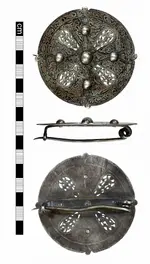spanish hawk
Greenie
- Joined
- Jan 8, 2020
- Messages
- 10
- Reaction score
- 19
- Golden Thread
- 0
- Detector(s) used
- 400i
- Primary Interest:
- All Treasure Hunting
- #1
Thread Owner
Saw this newspaper article the other day. Good news.
17th march 2020. The British Museum on Tuesday announced that 1,311 finds which are defined as treasure had been found by members of the public across England, Wales and Northern Ireland in 2019.
They also included an iron age drinking set, a solid gold bronze age arm ring and a coin which helps tell the story of Carausius, a usurper emperor who in 286AD broke Britain away from Europe, in an adventure which ended badly.
Michael Lewis, the head of the British Museum’s portable antiquities scheme, said the 1,100-year-old brooch discovered in Norfolk was a particularly striking and rare discovery.
“It is an amazing example of Anglo-Saxon art of the period,” he said. “When the finder found it the reaction was, is this old? It could be something more modern which was inspired by the past. Your gut reaction might be that it was Victorian.”
The brooch has a distinctive stylised Anglo-Saxon decoration called Trewhiddle. It features plant motifs, geometric design and animal art which seems to include boar, dragons and dog-like creatures.
“On the back it still has its catch plate so in some ways you could almost pop it back on and wear it again, it is in such good condition,” said Lewis.
It was found in Great Dunham Norfolk but the topsoil was composed of recently delivered soil from a tipper truck. That means it could originate from the Pentney area, which would make sense given its similarity to spectacular brooches from there that are in the national collection.
In total, 81,602 finds were recorded with the portable antiquities scheme. Many of them may not appear to amount to much but they were all important, said Lewis.
Other finds include a pure gold arm ring weighing 300g and dating from the eighth century AD which was found at St Bees, Cumbria, North West England.
17th march 2020. The British Museum on Tuesday announced that 1,311 finds which are defined as treasure had been found by members of the public across England, Wales and Northern Ireland in 2019.
They also included an iron age drinking set, a solid gold bronze age arm ring and a coin which helps tell the story of Carausius, a usurper emperor who in 286AD broke Britain away from Europe, in an adventure which ended badly.
Michael Lewis, the head of the British Museum’s portable antiquities scheme, said the 1,100-year-old brooch discovered in Norfolk was a particularly striking and rare discovery.
“It is an amazing example of Anglo-Saxon art of the period,” he said. “When the finder found it the reaction was, is this old? It could be something more modern which was inspired by the past. Your gut reaction might be that it was Victorian.”
The brooch has a distinctive stylised Anglo-Saxon decoration called Trewhiddle. It features plant motifs, geometric design and animal art which seems to include boar, dragons and dog-like creatures.
“On the back it still has its catch plate so in some ways you could almost pop it back on and wear it again, it is in such good condition,” said Lewis.
It was found in Great Dunham Norfolk but the topsoil was composed of recently delivered soil from a tipper truck. That means it could originate from the Pentney area, which would make sense given its similarity to spectacular brooches from there that are in the national collection.
In total, 81,602 finds were recorded with the portable antiquities scheme. Many of them may not appear to amount to much but they were all important, said Lewis.
Other finds include a pure gold arm ring weighing 300g and dating from the eighth century AD which was found at St Bees, Cumbria, North West England.




